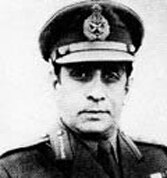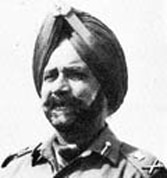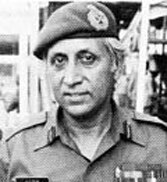Operation Bluestar: Answers to some unanswered questions
Nearly two months after the troops moved into Punjab, many questions still remained unanswered about Operation Bluestar, undoubtedly the biggest internal security mission ever undertaken by the Indian Army. Seeking answers to some of these questions Correspondent Shekhar Gupta interviewed scores of military and intelligence officials.


Was there an underestimation of the terrorist strength? And, finally, could the casualties have been minimized? Seeking answers to some of these questions Correspondent Shekhar Gupta interviewed scores of military and intelligence officials. His report:
For Major-General Kuldip Singh (Bulbul) Brar and his wife Meena. it was to be an elusive holiday in Manila. Just a day before they were booked on the flight, summons came from the Western Command headquarters at Simla for an urgent conference at Chandimandir cantonment near Chandigarh, the headquarters of the 2 Corps of the Indian Army. On the morning of June 1, the briefing hall was brimming with excitement. The western army commander Lt-General K. Sundarji and his chief of staff Lt-General Ranjit Singh Dayal were briefing a stunned audience of brass hats on the Operation bluestar plan. It is now known that the operation was subdivided along two specific coordinates:
- Operation Metal: To prise the extremists out of the Golden Temple and to neutralize Bhindranwale, the task given to Brar's 9 Infantry Division.
- Operation Shop: To raid extremist hide-outs all over the state and to mop up the terrorist remnants from the countryside.
In addition, there was the equally crucial Operation Woodrose, under which the army units were to move into the border areas, taking over pickets routinely held by the BSF. As far as possible, the pickets were to be held in at least a company strength. Plans had been carefully made out on each operation and with it all, barring Operation Shop, more or less over now, it would be time now for the top brass and defense analysis to dissect the operations.
Obviously, in months to come, a lot of talk at the army's College of Combat at Mhow would revolve around Operation Metal. A major debating point would be the large number of casualties on both sides and the damage to the Akal Takht and question whether some of it was avoidable.
Preliminary investigations, however, suggest that there had been a certain amount of underestimation of the fighting ability and the intensity of motivation among the religiously charged crowd around Bhindranwale. Together with lack of specific intelligence on the weaponry inside the temple and unexpected, last minute hitches, this must have at least partly contributed to the high casualty rate.
On the afternoon of June 3, as the first units of the army began the siege of the temple the generals still strongly felt that it would be possible to overawe the extremists with a show of strength and prevent large-scale bloodshed. But the first indications to the contrary came when the defenders refused to be queened with the bombardment of their high-rise pillboxes atop the Ramgarhia Bungas, the 18th century brick towers and the water tank behind Teja Singh Samundari Hall.
Knocked out first on the morning of June 4, the battlements were found to be manned again the following morning, forcing the army to use a tank firing from a distant locality near the Sultanwind Gate which provided a clear view to them of the fortification on the water tank.

It was at this stage that the commanders accepted the inevitability of an infantry assault into the temple. According to original plan, the 10 Guards commanded by Lt-Colonel Israr Khan were to break into theparikrama from the main clock tower gate. To join up simultaneously were the troops of 26 Madras, brought in hastily from Jalandhar, from the serais' side.
In view of the "plunging fire" from the battlements on the parikrama and the clock tower, the Guardsmen were to approach the gate following tanks and then spill over inside the parikrama, clearing rooms and battlements held by the extremists. Similarly, the Madrasis coming in from the other end were supposed to clear the other side.
And while the infantry did this, the commandos, not of the regular army but from the Special Frontier Force (BSF), an outfit run by the Cabinet Secretariat at Chakrata, also called the RAW's Establishment-22 (set up in the early '60s to train Tibetan refugees in guerrilla warfare) were supposed to assault the temple and the Akal Takht and deliver the coup de grace.
But in spite of the specialized gear, weapons and bullet-proof jackets, the BSF men, who were the only ones to have rehearsed the raid thoroughly, found the fire from the Akal Takht too daunting and, failing to break into the Akal Takht, asked for tank support.
Complications had, meanwhile, arisen elsewhere also. While the commanders waited impatiently, the Madrasis were seemingly taking too long to get to the parikrama. But as it later turned out, it was not for want of trying. The steel gate at the entrance facing the series had proved to be stronger than anticipated and a tank had to be used to knock it down. Again, just as they stepped in the Madrasis, commanded by Lt-Colonel Panikkar, ran into heavy fire and suffered casualties.
They again ran into stiff resistance from terrorists who had taken a deadly position inside a strategically-placed piao (drinking water stall). The problem was compounded as the troops of the Madras Regiment and a company of Kumaon Regiment, originally held as reserve, got mixed in the darkness on the steps leading to the parikrama, leaving the officers with the frustrating task of first separating their respective troops while the extremists inflicted casualties.
With commandos failing to break through at the Akal Takht, generals had already begun in terms of an old-fashioned infantry assault and reserves were being summoned in the form of 7th Battalion of the Garhwal Regiment, who were, in fact, part of the 15 Division. Brigadier A.K. Diwan, nicknamed "Cheeky" and deputy god of the 15 Division had come in to coordinate the transfer of his Division's troops to the operation and found himself in the parikrama, under heavy fire.
The infantry was facing its most daunting challenge from the machine-guns sited nine inches above the ground along the parikrama. The defenders had correctly guessed that the troops will first neutralize the rows of rooms on the two floors of the parikrama. Recalls an officer: "Shahbeg had shown shrewd judgment in siting the machine-guns nine inches above the ground to cover the area with what we call as the grazing fire. He knew the regular Indian army drill for such an operation where troops are taught to crawl and throw-grenades into the rooms one by one and the machine-guns would have slaughtered crawling troops."
Fortunately, the officers decided that the space in and around the parikrama was too narrow for the men to crawl around. They thus decided to hide behind the pillars and spring out occasionally to throw a grenade into a room.

This explains the high incidence of bullet injuries in the leg. Among the first to be wounded in the Guards' assault was company commander Major Jasbir Singh Raina, a Sikh. Later, the Madrasis lost young Lieutenant Ram Prakash Ruparia to a sniper's bullet. Ignoring the Akal Takht for the moment, Brar asked the infantry to first clear the first floor of the parikrama in spite of the casualties. The approach at the two ends was effectively guarded by extremists hiding in manholes placed right next to the staircases. The troops were ordered to improvise assault ladders, which they did.
Still trying to avoid a massacre, the commanders pressed the troops into a desperate bid to lob gas-grenades into the Akal Takht. The SFF commandos were again asked to somehow reach close enough to the building and lob canisters containing "CS" gas, supposed to be slightly stronger than ordinary tear-gas. According to the commanders, there were three reasons the move did not succeed:
- The gas-grenades can be launched only at very short distances. The cost of getting that close, in terms of casualties, was prohibitive.
- With most of the entrances and windows heavily sandbagged it was difficult to aim a canister inside the building.
- A stiff breeze also diminished the gas-grenades' effectiveness.
With the move failing and infantry pinned down by effective fire from the Akal Takht, the temple and parts of the parikrama, it was now time for frontal assaults. It was in one of these that the Kumaon Regiment's Major Misra, along with seven other ranks, was killed a few yards from the Akal Takht entrance. Facing the daunting prospect of moving over the heap of their bodies, a batch of volunteers from the Madras Regiment, led by a young captain, stormed into the building.
They were the first troops to have "contacted" the Akal Takht. Of the 10 volunteers, seven died in the narrow passage as they ran into a large body of extremists, two crawled back severely wounded and only the captain returned unhurt much later, after trying to retrieve an injured junior commissioned officer (JCO), who was ultimately abandoned. He was later caught by Bhindranwale's men. Tortured, and blown up with dynamite sticks.
By this time Brigadier (now Major-General) Diwan, who had almost by coincidence found himself inside the temple, had taken charge of the affairs. A decision was now made to use harsher methods and armored personnel carriers (APC's) of a mechanized infantry battalion were called in.
But the APC's of the Scot variety, which is wheeled and not tracked, unlike the more modern APC's had trouble coming down the steps from the entrance into the parikrama. A Vijayanta tank had to be summoned to break the marble steps. "This too was a tricky operation," recalls an officer, adding, "our fear was that if the tank rolls down or gets bogged down, it may block the only good entry point we had for armored vehicles." The tank, had to be used carefully, breaking a step at a time, reversing, and then repeating the process.
But even when the APC's finally made it to the parikrama, the move did not make too much difference as the extremists fired from a Chinese-made Rocket Propelled Grenade launcher (RGP-7), knocking out the lead APC and wounding Captain Hardev Singh in it. A decision was made to abandon the APC and while alighting, the driver was shot in the eye and killed. Alongside, yet another novel trick was being tried to neutralize the Akal Takht.
The commanders brought in a tank with its bright, blinding xenon lamps to momentarily blind defenders in the Akal Takht while the troops closed in. In conventional warfare, the lamp is used only for a few seconds at a time to light up a target and the filament burns out in just two minutes. The tank had to be replaced each time the filament was burnt and the intervening delay reduced the effectiveness of the move. Later, as the night wore on, xenon lights were used in short spells.
The commanders were now faced with a terribly difficult situation. The dawn was not too far away and, as a senior officer recalls, once the place was lighted, each of the nearly 800 troops inside the parikrama could have been picked out by snipers. This is when tanks of the 16 Cavalry were asked to come in. The tank-men were initially told to use only the "secondary armament", meaning thereby the machine-gun mounted on the turret. Later, however, the main gun was used too.
Simultaneously, an artillery colonel was asked to take an ancient 3.7 inch howitzer atop a tall building overlooking the Akal Takht. Officers explain the howitzer was chosen for shelling since it can fire straight on, horizontally, promising greater accuracy at close range. Initially the artillery-men tried to mount the gun atop the building of a nationalized bank. But in spite of generous help from scores of civilians it proved impossible to haul up the heavy artillery piece with ropes. Later another building was chosen. To ensure that the aim was accurate, the gunners first fired smoke shells, then the real fireworks began.
As shelling continued troops lay sprawling, firing intermittently. By the morning of June 6, resistance had diminished and there was guesswork among the commanders as to what had happened to Bhindranwale and his key lieutenants. At 11 a.m., officers recall, there was a mad dash-out from the Akal Takht building. Nearly 25 men sprinted across, probably trying to make for the temple building, but most of them were mowed down. A few threw away their weapons and succeeded in jumping into the holy tank. They were killed there.
The suicidal break-out made the generals guess that Bhindranwale had by now died or escaped. Yet, till the evening, stray firing continued. It was later discovered that a handful of survivors inside had been keeping the army's attention diverted with stray sniping to gain time to throw weapons, cash and valuables in a well behind the Akal Takht building. Later in the day the troops caught a wounded youngster, perhaps a temple sewadar (worker), crawling out of the Akal Takht, who first reported that Bhindranwale was dead and Shahbeg seriously wounded. He later look the jawans to the Akal Takht basement where Bhindranwale's body was found, in a heap of about 40.
Away from the main theatre of operations a body of troops near the serais was grappling with another problem - a thousand pilgrims, including many women and children were trapped inside the rooms. A majority of these were part of a jatha that had come from Sangrur to court arrest as part of the ongoing Akali morcha. The rest included SGPC employees, laborers and pilgrims who had come from faraway places on June 3, the martyrdom day of Guru Arjun Dev.

Survivors' accounts vary but it seems that panic gripped everyone and the army's warnings over megaphones often got lost in the din of gunfire and shrieks. Many pilgrims died as Bhindranwale's men threw grenades to prevent the Akali leaders from surrendering. Later, as the army got sniped at from a number of rooms in the parikrama and the serais the troops just threw grenades into the rooms.
"People were dying on both sides", recalls an officer, adding, "and there was no time to find out who was inside a room." Some of the pilgrims also died of thirst. It is believed that of the 765 civilians who died inside the temple complex over 50 per cent were pilgrims. The dead included 55 women and 15 children.
While brains at the Staff College and College of Combat would now be going into the finer points of the operation a few facts stand out prominently:
- There was certainly an underestimation of the extremists' armed strength and fighting ability. A clear indication of this is that only a 50-bed field hospital had been organized in Amritsar while the casualties crossed the 500-mark.
- There had been a lack of coordination among the army, the civil authorities and the police. This is obvious from the fact that the troops did not know about a small exit behind the Guru Nanak Niwas through which over 150 persons, including many key extremists of the Babbar Khalsa faction, escaped.
The army's argument here would be that active coordination with the police would not have served the cause of secrecy which was of paramount importance. In any case, as an officer explained, this was the most unusual and undoubtedly the trickiest operation ever carried out in the history of Indian security forces. And if such an operation did not leave a trail of ponderable, what else would?